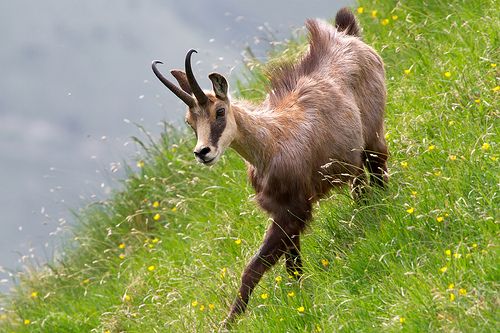Is a chamois a mountain climbing goat or antelope?
- Chamois are mammals originating in Europe’s mountainous habitats, and they have an appearance similar to a goat and antelope.
- Chamois are one of two species in the Rupicapra genus and they have the scientific name Rupicapra rupicapra.
- The diet of a chamois consists of vegetation including grass, bark, herbs, leaves and shrubs, and they are generally 70 to 80 centimetres (28 to 31 inches) in height and weigh between 25 to 60 kilograms (55 to 132 pounds).
- Chamois are part of the subfamily Caprinae, or group of caprids or goat-antelopes that includes domestic sheep and goats, that in turn, are from the Bovidae family, the family of horned and cloven hoofed mammals.
- A chamois is typically brown to grey or black in colour with black and white prominent markings, including a black stripe on its back, and the fur colour changes according to the seasons.
Chamois
Image courtesy of Umberto Nicoletti/Flickr
- Female chamois generally live with their young in small groups of up to 30, although in winter they can reach numbers of up to 100; while the mostly solitary males attract these females by engaging in fellow male duels.
- The lifespan of a chamois ranges from 15 to 17 years, and up to 22 in captivity, with main predators being lynxes, eagles, brown bears and wolves.
- Chamois are hunted for their meat, fur and/or hide, while the latter is used to make smooth, liquid-absorbing leather known by the same name, although hunting is typically illegal.
- Chamois can leap up to 2 metres (6.6 feet) high and 6 metres (20 ft) in length, and can move at speeds of 50 kilometres per hour (31 miles per hour).
- Eight chamois originating from Austria,were deliberately introduced into the mountain regions of the South Island of New Zealand in the Pacific in 1907, with another two in 1914, and they have been legally hunted there since 1930.
Bibliography:
Chamois, 2013, A-Z Animals, http://a-z-animals.com/animals/chamois/
Chamois, 2014, Wikipedia, http://en.wikipedia.org/wiki/Chamois
Huffman, B, Rupicapra rupicapra: Chamois, 2004, Ultimate Ungulate, http://www.ultimateungulate.com/artiodactyla/rupicapra_rupicapra.html







